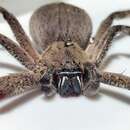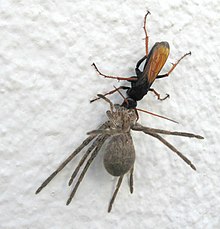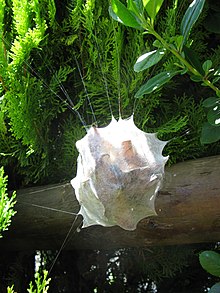fr
noms dans le fil d’Ariane


Palystes castaneus is a species of huntsman spider found in parts of South Africa.[1] It is common from Cape Town to Heidelberg, Western Cape, especially in forested areas. In scrub outside forested areas, it is replaced by Palystes superciliosus. It occurs mainly on plants, where it hunts insects. It has a body length of 17–22 mm.[2] P. castaneus is the type species for the genus Palystes, and was first described by Pierre André Latreille in 1819.[1]
Spiders in the genus Palystes are commonly called rain spiders, or lizard-eating spiders.[3] P. castaneus often appears in the home just before the onset of rain, where they hunt geckos (usually Afrogecko porphyreus). Males are regularly seen from August to December, probably looking for females.[2]
After mating in the early summer, the female constructs a round egg sac about 60–100 mm in size made of silk, with twigs and leaves woven into it. These egg sacs are commonly seen from about November to April. The female constructs the sac over 3–5 hours, then aggressively guards it until the spiderlings, who hatch inside the protective sac, chew their way out about three weeks later. Many gardeners are bitten by protective Palystes mothers during this period. Females will construct about three of these egg sacs over their two-year lives.[2]

P. castaneus (and other Palystes spiders) are also commonly seen paralysed, being dragged by a large wasp called a Pompilid wasp. Sometimes the wasp will not be present. Pompilid wasps only hunt spiders, which they paralyse by stinging them. They then drag the spider back to their nest where they lay an egg on the spider, then seal the spider and the egg in. When the egg hatches, the larva eats the paralysed spider, keeping the spider alive as long as possible by eating peripheral flesh first, and saving the vital organs till last. By doing this, the spider stays fresh long enough for the wasp larva to mature and pupate.[3] The Pompilid wasp species Tachypompilus ignitus is at least largely a specialist hunter of mature Palystes females.[4]
Palystes castaneus is a species of huntsman spider found in parts of South Africa. It is common from Cape Town to Heidelberg, Western Cape, especially in forested areas. In scrub outside forested areas, it is replaced by Palystes superciliosus. It occurs mainly on plants, where it hunts insects. It has a body length of 17–22 mm. P. castaneus is the type species for the genus Palystes, and was first described by Pierre André Latreille in 1819.
Spiders in the genus Palystes are commonly called rain spiders, or lizard-eating spiders. P. castaneus often appears in the home just before the onset of rain, where they hunt geckos (usually Afrogecko porphyreus). Males are regularly seen from August to December, probably looking for females.
 P. castaneus egg sac
P. castaneus egg sacAfter mating in the early summer, the female constructs a round egg sac about 60–100 mm in size made of silk, with twigs and leaves woven into it. These egg sacs are commonly seen from about November to April. The female constructs the sac over 3–5 hours, then aggressively guards it until the spiderlings, who hatch inside the protective sac, chew their way out about three weeks later. Many gardeners are bitten by protective Palystes mothers during this period. Females will construct about three of these egg sacs over their two-year lives.
 Tachypompilus ignitus dragging Palystes prey (not P. castaneus) up a wall
Tachypompilus ignitus dragging Palystes prey (not P. castaneus) up a wallP. castaneus (and other Palystes spiders) are also commonly seen paralysed, being dragged by a large wasp called a Pompilid wasp. Sometimes the wasp will not be present. Pompilid wasps only hunt spiders, which they paralyse by stinging them. They then drag the spider back to their nest where they lay an egg on the spider, then seal the spider and the egg in. When the egg hatches, the larva eats the paralysed spider, keeping the spider alive as long as possible by eating peripheral flesh first, and saving the vital organs till last. By doing this, the spider stays fresh long enough for the wasp larva to mature and pupate. The Pompilid wasp species Tachypompilus ignitus is at least largely a specialist hunter of mature Palystes females.
Palystes castaneus is een spinnensoort in de taxonomische indeling van de jachtkrabspinnen (Sparassidae).[1]
Het dier behoort tot het geslacht Palystes. De wetenschappelijke naam van de soort werd voor het eerst geldig gepubliceerd in 1819 door Latreille.
Bronnen, noten en/of referentiesPalystes castaneus là một loài nhện trong họ Sparassidae.[1]
Loài này thuộc chi Palystes. Palystes castaneus được miêu tả năm 1819 bởi Latreille.
Palystes castaneus là một loài nhện trong họ Sparassidae.
Loài này thuộc chi Palystes. Palystes castaneus được miêu tả năm 1819 bởi Latreille.